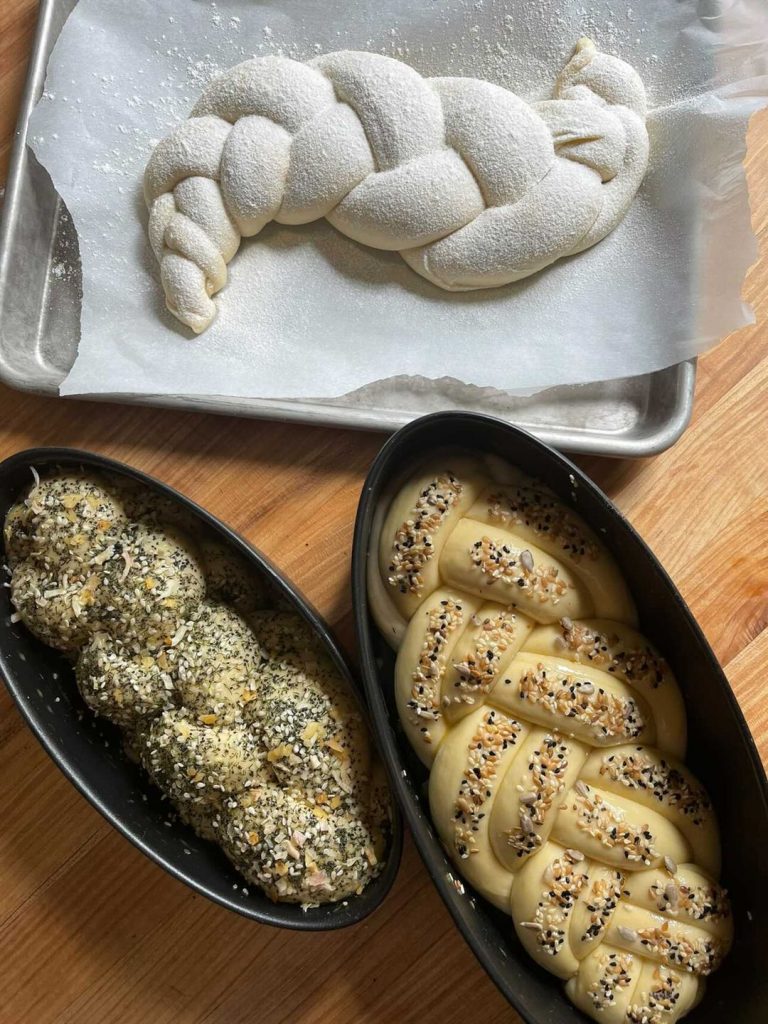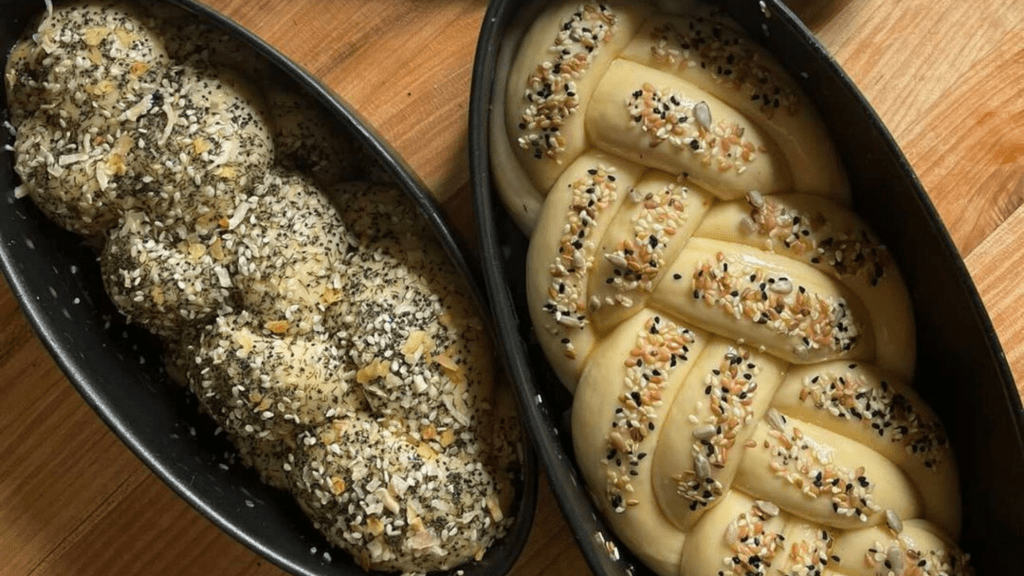This recipe comes from Naomi E., who is a recipe developer. She’s always posting new recipes on her Instagram along with helpful tips & information. Her popular Instagram account has over 34.9k followers and anyone who tries her recipes will understand why!
We hope that you enjoy the recipe as much as we do! Below are her instructions and tips. For videos of the process view here for part one and view here for part two.
For more recipes be sure to follow!

Ingredients
- 2 Cups Warm Water
- 1-2 Tbsp Granulated Sugar (For proofing)
- 2 Tbsp Active Dry Yeast
- 2 Tbsp Honey
- 1/2 – 3/4 Cups Granulated White Sugar (Depending on your sweetness preference)
- 1/2 Cup Neutral Oil (Canola used)
- 1 Large Egg (Add an extra egg if you want fluffier challah)
- ~5-7 Cups High Gluten or Bread Flour
- 1 1/2 Tsp Fine Pink Himalayan Sea Salt or Fine Sea Salt
Instructions
- Mix sugar with water and yeast.
- Once the yeast begins to bubble, it’s time to add the rest of your wet ingredients followed by the flour and salt.
- Start with 5-6 cups of flour adding as you need until the sides of the bowl become clean.
- Turn off the mixer.
- Let the dough rest for 3-5 mins to relax the gluten.
- Feel the dough to see if you need to add more flour; mix with dough hook again for 3-5 mins on medium until smooth and elastic.
- Transfer the dough to a greased dough bucket; the numbers on the side help if you’re not sure when/if your dough is “doubled” in size.
- Cover the dough bucket with greased plastic wrap/ a moist clean lint-free towel so the dough doesn’t dry out.
- Let dough rise at room temp (Approx 45 mins- 1 hour and depending on the time of year) OR in the fridge (12-24 hours).
Fun Fact: Challah is considered an enriched dough and greatly benefits from a long cold rise. This helps improve texture and develops flavor.
“Flour Power” Look at the nutritional info on your bag of flour, the protein content in particular. Did you know the % of protein listed on the bag corresponds to how much gluten is formed?
1- Low protein: 7.5-9% a soft textured flour perfect for cakes and pastries.
2- All Purpose: 9-11%- A mid-range protein level perfect for most baked goods like cookies and muffins.
3- Bread/High Gluten: 12-14% protein content = + elasticity, chew, texture.
4- Whole Wheat: 14% protein (yet the exception to the rule) whole wheat flour is made by milling the entire berry, yet when ground the sharp edges cut the strands of gluten that form in the dough therefore we compensate with additional gluten.
Challah Dough Adaptations
Whole Wheat: Use approx 2 1/2-3 c EACH whole wheat flour and high gluten bread flour. If you want to make your dough using 100% whole wheat flour you will want to add something called vital wheat gluten which can be found in most supermarkets or online; vital wheat gluten is also known as “bread improver” it’s made of dried gluten and is added to whole grain flour-based doughs to compensate for the lack of gluten produced by these types of flours. For every cup of whole-grain flour add 1 1/2 tsp-1 Tbsp bread improver( suggested amount should be listed on the package). Whole grain flours absorb water at a slower rate than white (flour) so avoid the mistake which is often made (adding too much flour) your whole wheat dough should have a slight stickiness to it before its put up to rise; it’ll dissipate by the time it’s ready to shape. You can always add more flour but you can’t take any away. If you do think you added too much flour before putting your dough up to rise (aka your dough is dry). Add some water to your dough (a little at a time) as you knead. If you’re new to the whole grain game start slow by replacing 25% of the flour called for with whole wheat and increase from there.
Spelt: Spelt is more water-soluble than wheat and contains a higher level of gliadin (the protein that makes dough spread/ stretch). Using less liquid can help prevent this: Try cutting the water back (in this recipe or your fave challah dough recipe) by approximately 25%.
More Whole Grain Bread Tips:
1- Quality Matters. Use unprocessed raw honey and fine pink salt.
2- Replace 1 cup water with seltzer/ sparkling water (proof yeast, sugar, and 1 cup warm water then add the bubbly stuff and the remaining wet ingredients to the mix before adding flour and salt)
3- Because whole grains take longer to absorb water some people are a bit put off and worried about adding too much flour. Try this: Add a little less whole grain flour to your dough than the recipe calls for; mix until a shaggy dough forms ( it’ll look dry and unkempt) cover and rest 30 mins before kneading it fully; you’ll get a better idea if/ how much you need to add more flour, then can continue with the recipe.
Did you make this recipe?
Tag @naomi_tgis on Instagram and hashtag it #boschmixers

